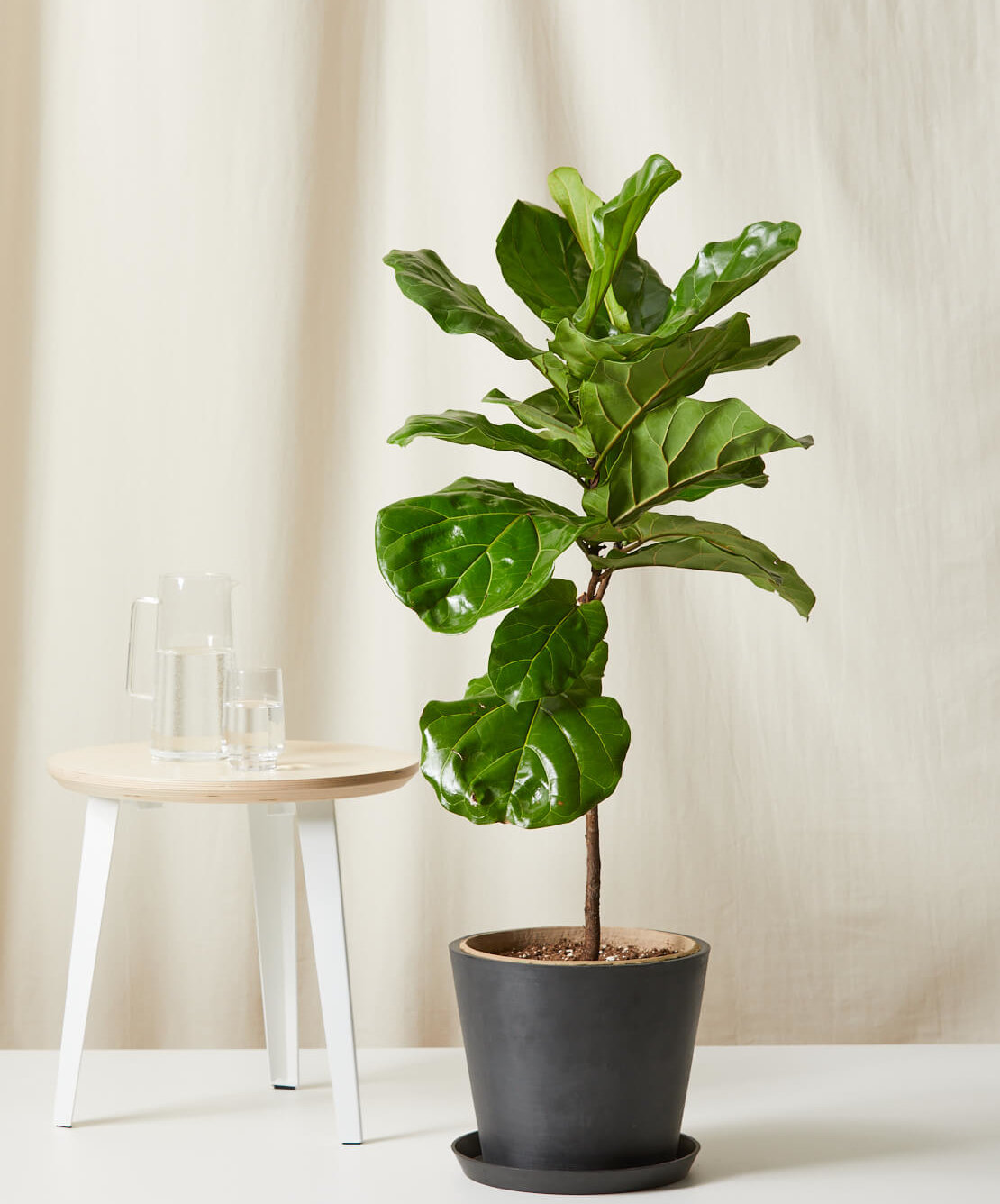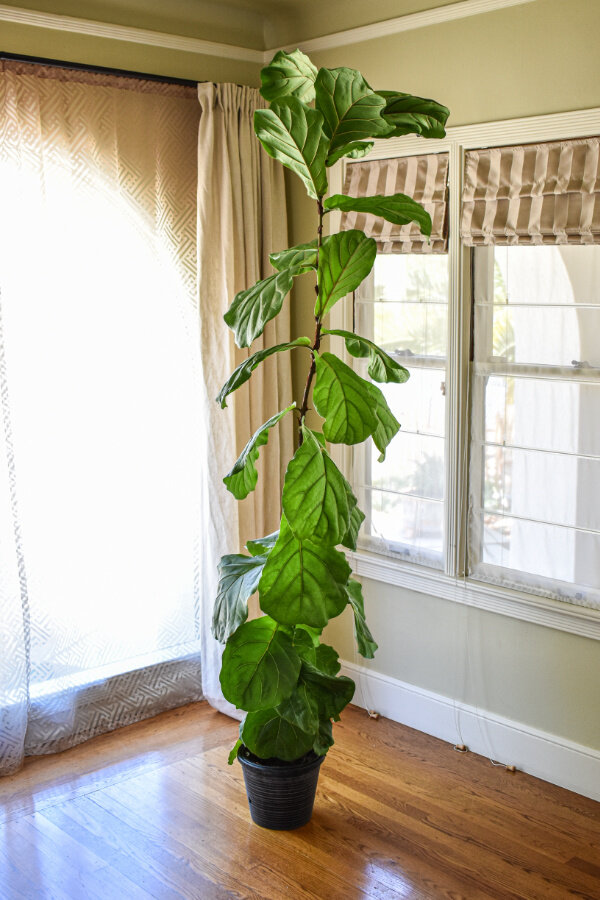To replant a fiddle leaf fig, carefully remove the tree from its current pot and place it in a larger container with fresh potting mix. When repotting, be sure to handle the delicate roots with care to avoid damage.

Credit: bloomscape.com
How to Replant a Fiddle Leaf Fig: Step by Step Guide
Choosing The Right Pot For Your Fiddle Leaf Fig
Choosing the right pot for your fiddle leaf fig is crucial for successful replanting. One important factor to consider is the presence of drainage holes. These holes help prevent water from accumulating at the bottom of the pot and causing root rot.
Another consideration is the size of the pot. It’s important to choose a pot that is slightly larger than the current one, allowing the roots to have enough space to grow. However, avoid choosing a pot that is too large, as it can retain excess moisture and lead to overwatering.
By carefully selecting the right pot for your fiddle leaf fig, you can ensure proper drainage and give your plant the space it needs to thrive.
Preparing Your Fiddle Leaf Fig For Repotting
When preparing your fiddle leaf fig for repotting, start by inspecting for signs of repotting needs. Check for rootbound roots or roots growing through the drainage holes. Gather tools and materials like a pot with drainage holes, potting mix, and a new pot that is one size up from the current one.
Before repotting, prune and trim your fiddle leaf fig to encourage new growth and prevent root damage. Remove any dead or yellowing leaves and trim excessive growth. Carefully lift the fiddle leaf fig from its current pot, being gentle with the roots.
Place it in the new pot, adding fresh potting mix around the roots, ensuring it is firmly rooted. Water the plant thoroughly and place it in a location with bright, indirect light. Regularly monitor its watering needs and adjust as necessary to promote healthy growth.
Replanting Your Fiddle Leaf Fig
Replanting a fiddle leaf fig requires careful steps. Start by removing the plant from its current pot without causing damage to the roots. Take the time to inspect the roots for any signs of disease or overgrowth. If there is any damage, address it by trimming away affected areas.
Next, select the ideal soil for repotting, making sure it is well-draining and nutrient-rich. These steps are crucial to ensure the health and longevity of your fiddle leaf fig. Proper care and attention during the replanting process will help your plant thrive in its new pot.
So take the time to follow these steps and give your fiddle leaf fig the best chance at success.
Transferring Your Fiddle Leaf Fig To A New Pot
Transferring your fiddle leaf fig to a new pot? Start by placing a layer of soil at the bottom. Carefully center the fiddle leaf fig in the new pot. Then, add soil around the fiddle leaf fig, ensuring it is secure.
Remember to avoid overusing words and phrases for better readability. Following these steps will help you successfully replant your fiddle leaf fig.
Caring For Your Newly Repotted Fiddle Leaf Fig
Replanting a fiddle leaf fig involves caring for it properly after the process. One crucial aspect is the watering and moisture requirements. It is vital to water the plant appropriately, ensuring the soil is evenly moist but not waterlogged. Pay close attention to the plant’s needs, adjusting the amount and frequency of watering as necessary.
Aside from water, the plant’s light and temperature conditions should also be considered. Find the right spot in your home where it can receive bright, indirect sunlight and stay away from extreme temperature fluctuations. Lastly, it is essential to monitor the plant for any signs of stress or disease.
Regularly inspect the leaves, stems, and roots for any discoloration, pests, or diseases. By following these guidelines, you can ensure the health and growth of your newly replanted fiddle leaf fig.
Common Mistakes To Avoid When Replanting
Mistakes while replanting a fiddle leaf fig can be easily avoided. Overwatering leads to root rot and leaf drop. Ensure proper drainage to prevent waterlogging. Use a well-draining soil mix with perlite or sand. Avoid dense or compact soil that can retain moisture.
Opt for loamy soil that provides a balance of moisture and aeration. Remember to repot your fiddle leaf fig in a pot that has drainage holes. Properly transplanting your fiddle leaf fig will promote healthy growth and prevent common issues.
Keep these tips in mind to successfully replant your fiddle leaf fig and enjoy its beauty in your home.
Next Steps For Maintaining Your Fiddle Leaf Fig
Replanting a fiddle leaf fig requires the next steps for maintaining it. Once you’ve replanted your fig, creating a regular watering schedule is crucial. Determine the right amount of water, ensuring the soil is evenly moist without being overly saturated.
Fiddle leaf figs also benefit from proper fertilization. Utilize a balanced fertilizer during the growing season, following the instructions on the package. Monitoring and adjusting light conditions is important too. Fiddle leaf figs thrive in bright, indirect light, so find a spot with ample sunlight but avoid direct exposure.
By following these steps, you can enjoy a healthy and vibrant fiddle leaf fig for years to come.
Troubleshooting Common Issues With Fiddle Leaf Fig Plants
Are you facing issues with your fiddle leaf fig plant? Yellowing or browning leaves could indicate nutrient deficiencies. Ensure proper fertilization and sunlight. Leaf drop or wilting may be caused by improper watering and drainage. Adjust your watering schedule and repot if necessary.
Pests like mealybugs and diseases like root rot can harm your plant. Regularly check for signs of infestation or disease and take prompt action. By troubleshooting these common problems, you can revive your fiddle leaf fig and ensure its healthy growth.
Remember to provide the right conditions and care for your plant to thrive. Replanting may also be necessary if the root system becomes overcrowded. With proper attention, your fiddle leaf fig can become a beautiful addition to your home or office.
Final Thoughts On Successfully Replanting A Fiddle Leaf Fig
Replanting your Fiddle Leaf Fig can be a gratifying experience. By successfully giving your plant a new home, you can celebrate your accomplishment and enjoy the beauty it brings to your space. Sharing your love for Fiddle Leaf Fig care with others is a great way to spread knowledge and help fellow plant enthusiasts.
And the learning never stops! Continue to improve your plant care skills as you explore new techniques and strategies. With each successful replanting, your confidence will grow, and your green thumb will flourish. So, roll up your sleeves, grab your gardening tools, and get ready to give your Fiddle Leaf Fig the best possible start in its new home.
Enjoy the journey of nurturing and growing your plant!
Frequently Asked Questions For How To Replant A Fiddle Leaf Fig
How Often Should I Water My Fiddle Leaf Fig?
It is recommended to water your fiddle leaf fig once every 7-10 days. However, ensure the top inch of soil is dry before watering again, as overwatering can lead to root rot. It’s better to underwater than overwater your plant.
How Do I Know If My Fiddle Leaf Fig Needs More Sunlight?
If your fiddle leaf fig’s leaves are dropping or turning brown, it may be a sign that it needs more sunlight. Place your plant near a window that gets bright, indirect light for a few hours each day. Avoid placing it in direct sunlight as it can scorch the leaves.
What Type Of Soil Is Best For Replanting A Fiddle Leaf Fig?
For replanting a fiddle leaf fig, use a well-draining potting mix that is specifically formulated for houseplants. A mix of peat moss, perlite, and pine bark is recommended. Avoid using garden soil as it can become compacted and hinder proper drainage.
Can I Propagate My Fiddle Leaf Fig By Replanting A Leaf?
No, fiddle leaf figs cannot be propagated by replanting a leaf alone. They can only be propagated through stem cuttings. Take a cutting with at least two leaves and insert it into a moist soil mix. Keep the soil consistently damp until roots develop, which usually takes about 6-8 weeks.
Conclusion
Replanting a fiddle leaf fig can be a rewarding process that allows you to breathe new life into your beloved plant. By following the proper steps, such as preparing the new pot and soil, gently removing the plant from its current container, and providing adequate care and attention afterwards, you can ensure a successful transition for your fiddle leaf fig.
Remember to choose a pot that allows for future growth, use well-draining soil to prevent waterlogging, and consider adding a layer of mulch to retain moisture. Regular watering, adequate sunlight, and occasional fertilization will help your fiddle leaf fig thrive in its new environment.
With patience and care, you can enjoy the beauty of this trendy houseplant for years to come. Happy replanting!

